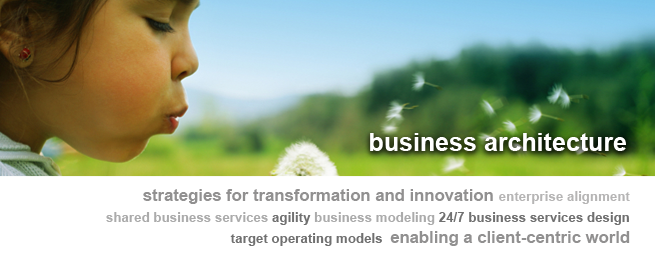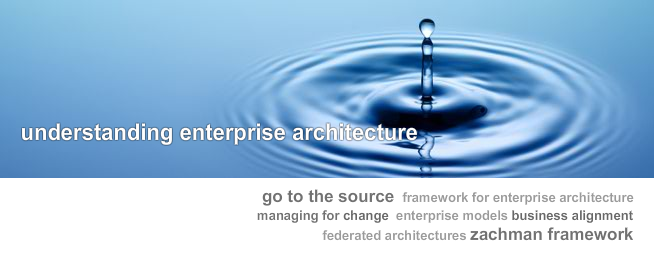hi
Enterprise ARchitecture Management search
;;_))
Enterprise Architecture in Spain. ------------------------------------------------------------------------------------------------------- Arquitectura Empresarial en España. ---------------------------------------------------------------------------------------------------- A collection of EA things (post, twits, files, blogs...) I find on the internet (TOGAF, Zachman, PEAF, FEAF, Gartner ...)
one Gartner definition
EA is a process discipline that is often misunderstood. Done well, it becomes part of how an organization makes decisions to direct its investments, such that the chosen business strategy is realized. The EA process bridges the gap that often exists between business strategy and implementation.
http://www.gartner.com/DisplayDocument?ref=seo
;;_))
Permita alinear la tecnología con sus objetivos empresariales.
EAM provee la solución por medio de la utilización de habilidades orientadas al resultado y métodos para crear, implementar, actualizar y mantener un esquema de trabajo empresarial y tecnológico. Esto lo ayudará a alinear los procesos de su organización, a manejar la vida útil de la información, a racionalizar aplicaciones y a reestructurar infraestructuras para crear un valor real.
Documente el estado actual de su organización (as-is), analice el ecosistema de tecnologías de información y procesos de negocio, planee el estado futuro (to-be), identificando brechas, priorizando y dando seguimiento a las iniciativas y proyectos.
EAM presenta una visión integrada de planificación (visión, estrategia, objetivos, propósitos), operaciones (organizaciones y procesos) y datos/flujos de información; así como también, arquitectura de aplicación (sistemas) y una infraestructura tecnológica habilitante en toda la empresa.
Combine tecnologías de gestión BPM, con estándares globales de arquitectura empresarial EAM. Planifique, visualice y evalúe tecnologías, procesos, datos y estructuras organizativas sin redundancia alguna.
http://kaf.com.mx/home/menu-styles-mainmenu-47

hi
Some companies with EA courses
http://enterprisearchitecturetraining.com/
http://www.enterprisearchitects.com/
https://online.ist.psu.edu/ea/
Introduction to Enterprise Architecture (IST 497a) is a unique course development in conjunction with several leading corporations and industry associations. IST 497a is designed to be the first exposure to foundational enterprise architecture (EA) concepts and practices. The course sets the “common language” for EA discussions for professionals new to the EA field as well as functional business people, customers, suppliers, and others who desire an overview of enterprise architecture and the benefits it can bring to an organization. The course is not centered on a particular EA framework or methodology, but is designed to provide foundational knowledge and perspectives that apply to all organizations, regardless of the particular EA approach followed within the organization.
Students who complete this course will receive a certificate of completion from Penn State. Additional details may be obtained explaining how to register for and take an optional certification exam for a new industry certification associated with this course from the Open Group. Students may also earn graduate independent study credits toward the new online Master of Professional Studies Program in Enterprise Architecture at Penn State.
The course is a forty-hour, self-paced online educational program that provides access and interaction with a faculty member who was involved with the design and development of the course.
The course is organized into three main modules that consist of five to six supporting topics. These topics can be accessed via the Course Content link under the Lessons Tab in ANGEL. The first time you go to the course content page, you will need to log in with your Penn State ID. Once into the content, you can navigate it like a regular website. The activities for the course are located in ANGEL. Each topic has discussion activities and knowledge check questions. You can see the corresponding files in ANGEL.
This module introduces the foundational concepts behind enterprise architecture and discusses the business value that enterprise architecture brings to the organization. The module discusses the nature of complex organizations and provides an overview of the layers of the enterprise technology architecture.
This module discusses fundamentals of planning for enterprise architecture initiatives, modeling the different layers of the enterprise, and building and maintaining an EA. The importance of governance and change management for EA success is also explored.
This module discusses topics related to successful EA implementation. The importance of leadership and effective decision making to the success of EA is explored as well as the composition and management of the EA project team. Factors that influence the success of EA in an organization are discussed as well as concepts and issues surrounding the measurement of EA value and risk identification and analysis for EA initiatives. The module concludes with a comparison of popular EA frameworks and a discussion of “hybrid” EA frameworks.
We wrap up the course with an overview of the EA profession and future trends. We hope you enjoy the course!
hi
post in Spanish from a Colombia company
http://www.ubiquando.com.co/index.php/Productos-y-Servicios/arquitectura-empresarial.html
;;_))
Hi
For PCs
http://pubs.opengroup.org/architecture/togaf9-doc/arch/
For Tablets and Smarphone
http://pubs.opengroup.org/architecture/togaf9-doc/m/
;;_))
Hi
Another big company from Canada for EA courses
http://www.webagesolutions.com/training/enterprise_architecture/
This course provides a balanced experience, deftly blending academic content with practical hands-on lab exercises Attendees will begin the course with an informal collection of architecture concepts, strategies, and work products, and conclude the workshop with a comprehensive approach to organizing and practicing the discipline of architecture.
More Info
This four-day, hands-on workshop explores EA and the move within organizations to adopt a rigorous process for describing the current and future states of an enterprise's maturity as well as mapping out the steps necessary to move the organization forward. This course will equip architects and team leads with a working knowledge of EA, hands-on experience applying some of the most popular frameworks such as Zachman, TOGAF, DoDAF, MoDAF, FEAR, and TRAK. Additionally, this course will provie a broad awareness for the implications of EA and how to best support the adoption of EA through changes to people, processes, and technology.
More Info
This two day course provides a comprehensive introduction to the discipline and methodology of Enterprise Architecture (EA). The course is designed for architects and team leads who are new to EA. It will provide the high level concepts behind EA, its value proposition within enterprises, and an understanding of how to apply EA in practice. It will also discuss the various roles and responsibilities involved in effective EA adoption. In addition to high-level concepts and methodologies, this course will provide a practical understanding of how EA is developed in a step-by-step process.
More Info
This course, through its nine chapter modules, is designed to provide the knowledge and skills necessary to build robust, scalable, and maintainable architectures. It teaches a methodology and a set of techniques that show how to ensure that all aspects of architecture are covered and documented. It also instructs students in a set of architectural structures and patterns essential in building enterprise architectures. Particular attention is given to topics that improve the precision and quality of developed systems. Every module ends with a quiz to ensure mastery of the subject matter.
More Info
This half-day seminar introduces EA, key frameworks, models and approaches, EA practice and governance, as well as provides a realistic look at the EA value proposition. This seminar will provide decision makers with the essential understanding of Enterprise Architecture and where to start when putting EA into action in your organization.
More Info
Coming
Soon
This two-day workshop explores EA and the importance of implementing governance around such a monumental initiative. The adoption of a rigorous process for describing the current and future states of an enterprise’s maturity as well as defining a progressive roadmap should not be done in an ad-hoc fashion. This course will equip managers, architects, and team leads with a clear understanding of the challenges and risks associated with EA adoption as well as key strategies to mitigate these risks. Significant attention will also be given to the proper way to engender organizational change, champion the EA initiative, and best practices around managing enterprise architecture, business processes, and ensuring alignment with strategic objectives. EA can be adopted incrementally, contractually managed by policies and SLAs, and matured over time alongside the natural evolution of the enterprise. The key to this is governance.
More Info
This two-day seminar explores EA and the move within organizations to adopt a rigorous process for describing the current and future states of an enterprise’s maturity as well as mapping out the steps necessary to move the organization forward. This course will equip managers and team leads with a working knowledge of the scope of EA, a basic understanding for some of the popular frameworks such as Zachman, TOGAF, DoDAF, and EABOK, and a broad awareness for the implications of EA and how to best support the adoption of EA through changes to people, processes, and technology.
More Info
During the course students will become familiar with core components of the TOGAF™ Version 9 Enterprise Edition body of knowledge. They will learn about the Architecture Development Method (ADM), ADM Guidance and Techniques, the Architecture Content Framework, Enterprise Continuum, and other core elements of TOGAF™ 9. Upon completion of the course, students will be equipped to prepare for and pass the TOGAF™ 9 Foundation (Level 1) certification exam from the Open Group.
More Info
During the course students will become familiar with the TOGAF™ Version 9 Enterprise Edition body of knowledge. This course provides a comprehensive examination of the TOGAF specification, complete with a deep dive into the Architecture Development Method (ADM), ADM Guidance and Techniques, the Architecture Content Framework, Enterprise Continuum, and other core elements of TOGAF™ 9. Advanced topics, including architectural partitioning, iterative application of the ADM, and an examination of deliverables and how to go about tailoring the ADM will also be discussed. Upon completion of the course, students will be equipped to prepare for and pass the TOGAF™ 9 Certified (Level 2) certification exam from the Open Group.
More Info
For those individuals that choose to become certified in a step-wise fashion, this course builds upon an existing TOGAF™ 9 Foundation (Level 1) skillset to enable individuals to progress incrementally toward TOGAF™ 9 Certified (Level 2).
More Info
;;_))
hi
Intervista – Canada
http://www.intervista-institute.com/educational.php
Business Architecture outline course![]()

Day 1 | Day 2 & 3 | Course Fees | PDF Version | ShareThis
![]()
Day 1 – Strategy, Innovation and Business Architecture
1. The innovation imperative.
Challenges of business agility.
3. Real World Business Architecture.
Drives and imperatives for business architecture.
4. Identifying a Strategic Roadmap.
Getting started: Analysis of business.
5. From strategy to Business Architecture.
Bridging the gap.
In this interactive workshop, team members use a real world case study to understand the strategy of
introducing a direct self-service channel.
Days 2 & 3 Implementing Business Architecture for the Client-Centric Enterprise
1. Fundamentals of enterprise models.
Managing change.
2. Business services design.
Modeling for a client-centric world.

6. Modeling business processes.
Living in a world of distributed and virtual services.
7. Capturing policy and business rules.
Gaining enterprise agility.
8. From over-the-counter to 24/7.
A world of disintermediation.
9. Patterns in the business environment.
The power of reference models.
10. Managing the transformation portfolio.
The reality of priorities.
11. Building the business blueprint.
Achieving the adaptive enterprise.
Enterprise Architecture Course

Course Outline | Course Fees | PDF Version | ShareThis
![]()
2 Day Course - Understanding Enterprise Architecture
Framework Fundamentals
1. The innovation imperative.
Business drivers for Enterprise Architecture.
3. Addressing the paradoxical challenge.
Rapid delivery & enterprise infrastructure.
4. Behind the scenes.
EA implementation essentials.
5. For good measure.
The role of EA standards in successful implementation.
6. Planning the work.
Enterprise Architecture methodologies.
7. Working the plan.
Enterprise Architecture practicalities.
;;_))
Hi
http://isismjpucher.wordpress.com/2009/05/14/why-a-business-architecture/
May 14, 2009 by Max J. Pucher
The main goal of a Business Architecture (as a subset of Enterprise Architecture) is to enable the business to improve customer service quality through a better transparency, flexibility and adaptability of business operations. The market environment changes more rapidly and the use of technology by customers dramatically influences how a business can operate. Financial services calculation processes, marketing programs, business rules and content change already weekly rather than monthly. A BA includes both the definitions for a business strategy and business processes, which are linked through goals and outcomes.
However, if a business architecture has to be modeled, encoded and assembled by using a large number of tools and software components it cannot provide the benefits. Today’s heavily fragmented and hardcoded-integrated IT systems (including SOA) are too rigid to enable rapidly changing business environments. Most IT departments do not focus on adaptability and innovation because they have been requested to focus on lowering cost and system stability. Therefore, six month rollout cycles are the norm with three month being the exception. Business users expectations of stability and executive demands for lower cost are incompatible with the ability to achieve a flexible and adaptive, competitive IT infrastructure. Efficiency is still the main IT goal, with effectiveness a far-off second and agility being no more than an overused buzzword….
;;_))
hi
http://isismjpucher.wordpress.com/2010/07/10/architecture-model-adaptive/
July 10, 2010 by Max J. Pucher
The discussion about ADAPTIVENESS in processes or knowledge work leads to interesting avenues. Here are a few recent examples:
Jim Sinur – Gartner: ‘Got Social Processes’ proposes a range of process types from structured to ‘guiding’ processes with more and more social interaction. I wonder how others feel, but to me SOCIAL (or its kin E20) by its definition means open and uncontrolled interactions of people and not managed processes. I have posted a graphic about a similar spread of interaction types in March 2010 when I commented on Jeanelle Hills BPM predictions, but I see them as different technologies and concepts. Jim says that he wants to stay away from a technology discussions, therefore he does not consider HOW these technologies would practically integrate and interact. However integrated, adding ‘social’ free-text-snippets to orthodox BPM does not improve processes or make them adaptive. Only completely new technology can provide all these variants of process interactions. To become adaptive and thus allow any form of case or process, the BPM technology needs enable the user creation of new goals, tasks, rules, content and participants during execution. That has nothing to do with being ‘social’ and it isn’t ‘ad-hoc’ processes. You can read more in ‘Mastering the Unpredictable’!
Let me state here again that adding SOCIAL capabilities does not provide the dynamics, flexibility and adaptiveness that knowledge work requires. If that wouldn’t be so, then Lotus Notes would be the one and only system because it provided those social features a long time ago, including forms and collaboration.
hi
TOGAF y BA software
Bizzdesign Company
http://www.bizzdesign.com/tools/bizzdesign-architect/
http://iea.wikidot.com/bizzdesign-architect

;;_))
hi
Three ISO 20000 links in Spanish
http://es.scribd.com/doc/74421045/Norma-ISO-20000-Modo-de-ad
http://es.scribd.com/doc/95758785/Guia-ISO-20000
http://www.slideshare.net/SnypMystiko/iso-20000-9621619
;;_))
Hi
nice PPT
Create an Enterprise Architecture Board
Setup the Enterprise Architecture Framework
Setup the Enterprise Architecture Framework
;;_))